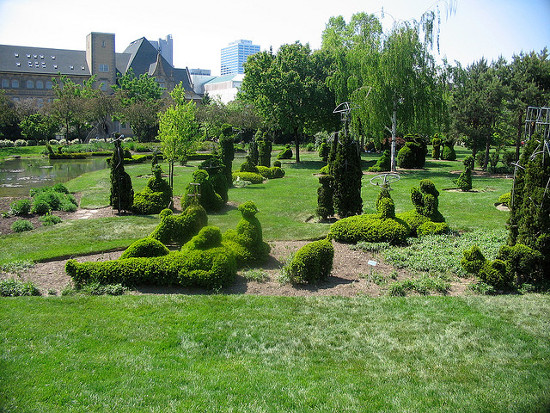
James Mason’s topiary park in downtown Columbus, Ohio, was inspired by Georges Seurat’s A Sunday Afternoon on the Island of La Grande Jatte, below.
So the image above is a photograph of a sculpture of a painting of a landscape.
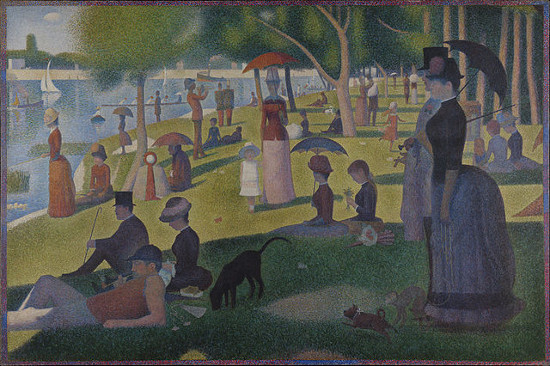

James Mason’s topiary park in downtown Columbus, Ohio, was inspired by Georges Seurat’s A Sunday Afternoon on the Island of La Grande Jatte, below.
So the image above is a photograph of a sculpture of a painting of a landscape.

Artist Thomas Cole took up a grand theme in 1833 — The Course of Empire, a series of five paintings that depict the rise and fall of a civilization. The Savage State shows a prehistoric wilderness in which the only artificial note is a circle of teepees:
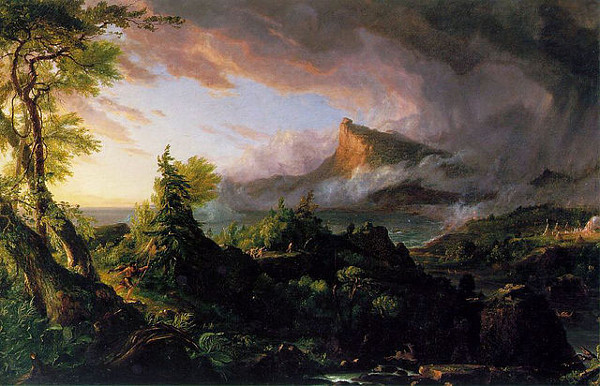
The Arcadian or Pastoral State shows the beginning of agriculture, with a primitive temple, farmers, and shepherds:
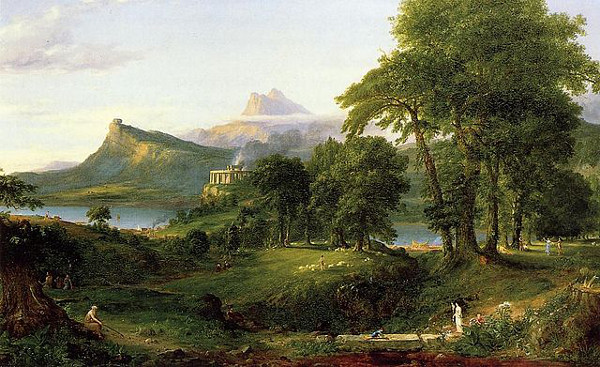
The Consummation of Empire shows a thriving city, with an imperial procession crossing a triumphal bridge:
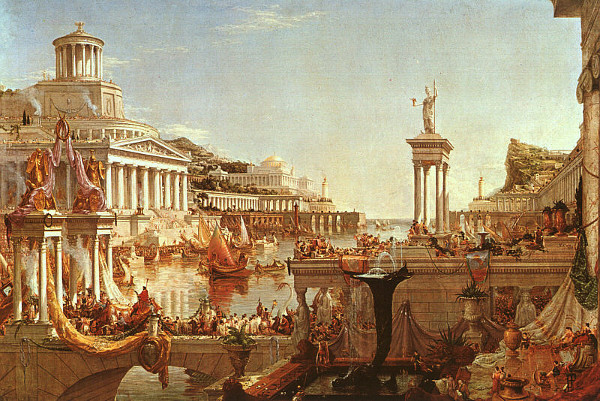
Destruction shows barbarians sacking the city and nature herself punishing human presumption:
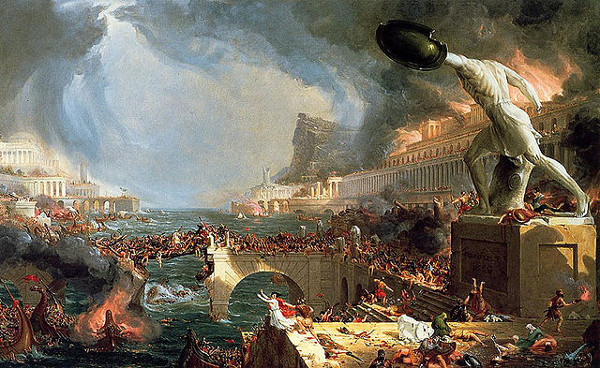
And Desolation shows the return of nature, with trees growing up through the ruins of the city:
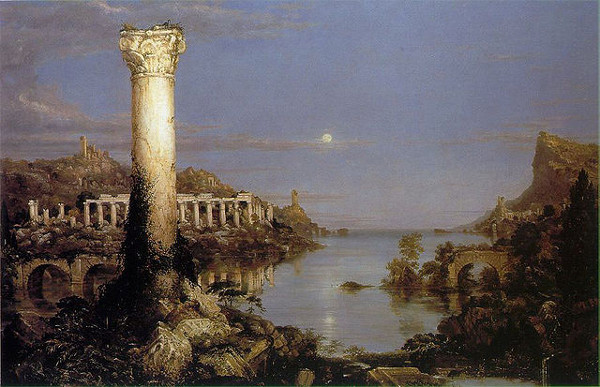
Interestingly, all five paintings depict the same scene: In the foreground is a natural port, and in the background is a distinctive mountain precipice. The time of day passes from dawn to dusk.
In 1836 more than 2,000 people attended the paintings’ exhibition at the National Academy of Design, an audience unprecedented in the United States. “The philosophy of my subject is drawn from the history of the past, wherein we see how nations have risen from the savage state to that of power and glory, and then fallen, and become extinct,” Cole had written to his patron Luman Reed. “You will perceive what an arduous task I have set myself; but your approbation will stimulate me to conquer difficulties.”
(Thanks, Cody.)

Artist Pierre Vivant performed a sort of typographical sleight of hand in an Oxfordshire field in 1990. In early summer oilseed rape changes from green to yellow as its flowers open. Vivant cut the words GREEN and YELLOW into the flowering field so that each word bore the color it named. Over the ensuing month, the flowers faded and the field reverted to green while the plants in the areas that Vivant had cut grew and flowered. The end result was the reverse of what you see here: a green field in which the word GREEN is yellow and the word YELLOW is green.
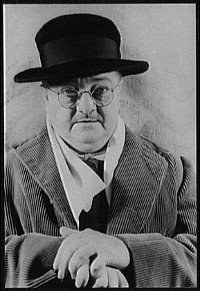
Alexander Woollcott set a world record for the shortest review of a Broadway play.
The play was titled Wham!
Woollcott’s review, in full, read “Ouch!”
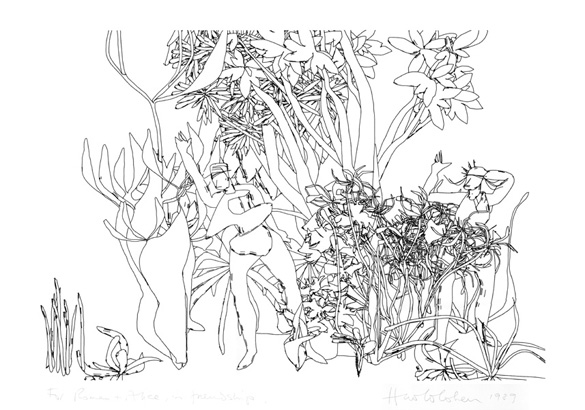
Shortly after joining the faculty of UC San Diego in 1968, British artist Harold Cohen asked, “What are the minimum conditions under which a set of marks functions as an image?” He set out to answer this by writing a computer program that would create original artistic images.
The result, which he dubbed AARON, has been drawing new images since 1973, first still lifes, then people, then full interior scenes with color. These have been exhibited in galleries throughout the world.
Carnegie Mellon philosopher David E. Carrier writes, “A majority of the viewers of AARON’s work find recognizable shapes in it; the drawing above appears to contain human figures. But AARON here used only the twenty or thirty rules it usually uses, with no special reference to human beings. Does knowing this tell us something about the structure of representation?”
Cohen asks, “If what AARON is making is not art, what is it exactly, and in what ways, other than its origin, does it differ from the ‘real thing?’ If it is not thinking, what exactly is it doing?”
“At the risk of stating the obvious, it seems to me that one of the things human beings find interesting about drawings in general is that they are made by other human beings, and here you are watching the image develop as if it is being developed by another human being. … When the drawing is finished, it functions as a human drawing. … A large part of what we value in art is not the ability of the artist to communicate special meanings, but rather the ability of the artist to present the viewer with something that stimulates the viewer’s own propensity to generate meaning.”
John Cage indicated that his 1987 piece Organ2/ASLSP should be played “as slow as possible,” but he declined to say how slow that is. Because a pipe organ can be rebuilt piecemeal as it plays, in principle there’s no limit to how long a performance can last.
In 1997 a conference of musicians and philosophers decided to take Cage’s instruction seriously and arranged a performance that would last 639 years. Fed by a bellows, a custom-built organ in the St. Burchardi church in Halberstadt, Germany, has been playing the piece since Sept. 5, 2001; it began with a contemplative 17-month pause, then played the first chord (A4-C5-F#5) for two years. Since then it’s got through only 12 changes; the next won’t occur until Sept. 5, 2020.
This will go on for another 620 years, ending on September 5, 2640. By that time someone somewhere will probably be playing it even more slowly.
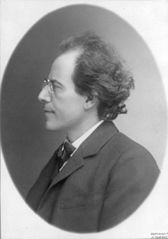
One characteristic incident of his fearlessness occurred when friends of Mahler recommended the Berlin Royal Opera to engage him just before he had signed to go to Hamburg. The intendant at the German capital, who was said to be anti-Semitic, is reported to have replied, ‘We cannot engage Mahler here, as we do not like the shape of his nose.’ When in 1897 Vienna offered Mahler the directorial and managerial control of its opera, Berlin suddenly awoke to the importance of the artist who was leaving Germany, and made him a proposition financially better than the one from Vienna. Mahler at once signed the contract to go to the banks of the Danube and telegraphed Berlin: ‘Regret that I cannot accept. My nose still the same shape.’
— Musical Courier, quoted in Current Literature, July 1911
See Late Acceptance.

Auric and I played all that Satie had written for the piano; one of us would play with him what he composed for four hands. Once, after we had played Morceau en forme de poire, I asked our hero, whom we called mon bon Maître, why he gave such a title, Pieces in the shape of a pear, to this ravishing music. He answered with a twinkle in his eyes: ‘You do know that I visit Debussy quite often; I admire him immensely and he seems to think much of whatever talent I may have. Nevertheless, one day when I showed him a piece I had just composed, he remarked, “Satie, you never had two greater admirers than Ravel and myself; many of your early works had a great influence on our writing. … Now, as a true friend may I warn you that from time to time there is in your art a certain lack of form.” All I did,’ added Satie, ‘was to write Morceau en forme de poire. I brought them to Debussy who asked, “Why such a title?” Why? simply, mon cher ami, because you cannot criticize my Pieces in the shape of a pear. If they are en forme de poire they cannot be shapeless.’
— Vladimir Golschmann, “Golschmann Remembers Erik Satie,” High Fidelity/Musical America, August 1972
(Thanks, Dan.)
On Nov. 11 each year the British Commonwealth observes two minutes’ silence to remember the fallen in World War I. Of the first observance, in 1919, the Daily Express wrote, “There is nothing under heaven so full of awe as the complete silence of a mighty crowd.”
In 2001, artist Jonty Semper released Kenotaphion, a two-CD collection of these silences drawn from 70 years of BBC, British Movietone, and Reuters broadcasts — he had spent four years assembling every surviving recording. “I really don’t think people will find it boring,” he told the Guardian. “This is raw history.”
Is this a contradiction, an audio recording of an absence of sound? “Unlike the Cenotaph at Whitehall, these recordings are far from empty, with Big Ben drowning out the coughs and uncomprehending children of the reverent, amid atmospheric weather effects, broadcast static, startled birds, and rifle reports,” notes Craig Dworkin in No Medium (2013). “The only truly silent Armistice minutes occurred during the Second World War, from 1941 to 1944, when the ceremony was suspended. Absent from Semper’s discs, those years speak the loudest and are by far the most moving.”
The final movement on John Coltrane’s 1965 album A Love Supreme is a “musical narration” of a devotional poem that Coltrane included in the album’s liner notes — he put the handwritten poem on a music stand and “played” it as if it were music.
“Coltrane’s hushed delivery sounds deliberately speechlike,” write Ashley Kahn in his 2003 history of the album. “He hangs on to the ends of phrases, repeats them as if for emphasis. He is in fact ‘reading’ through his horn.”
The hidden psalm was marked by New York musicians for decades before Rutgers University musicologist Lewis Porter presented a formal analysis to the American Musicological Society in 1980. “You will find that he plays right to the final ‘Amen’ and then finishes,” he writes in his 1997 biography of the saxophonist. “There are no extra notes up to that point. You will have to make a few adjustments in the poem, however: Near the beginning where it reads, ‘Help us resolve our fears and weaknesses,’ he skips the next line, goes on to ‘In you all things are possible,’ then plays ‘Thank you God’ … towards the end he leaves out ‘I have seen God.'”
“I think music can make the world better and, if I’m qualified, I want to do it,” Coltrane had said. “I’d like to point out to people the divine in a musical language that transcends words. I want to speak to their souls.”
(Thanks, Jeff.)